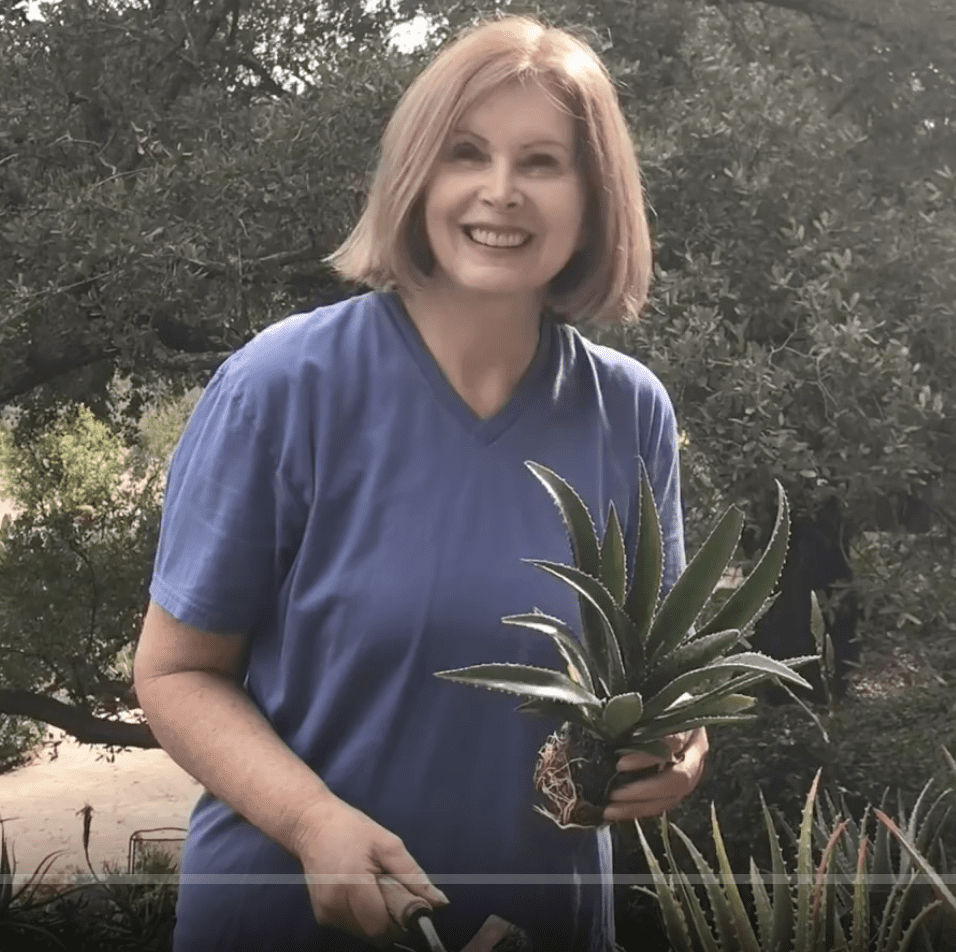
Testing Mangaves in My Garden
I’m testing more than 30 Mangave cultivars in my Zone 9b Southern CA garden. This is a report on the first batch of 14 that arrived two years ago from Hans Hansen of Walters Gardens, a wholesale perennial grower in Zeeland, MI. Hans is the world’s leading breeder of mangaves, and the first to reproduce them via tissue culture.
The hard part for breeders is selecting the true champions. Like a litter of puppies, plant crosses may look terrific, but how will they behave? It may take years to find out, and reports (like this) from gardeners far and wide provide important data.
Mangave is an intergeneric cross of Manfreda and Agave, and in the list below I’ve included each cultivar’s parentage (if available). All have speckled, dotted or blotchy leaves unless otherwise noted.
A bit of horticultural backstory
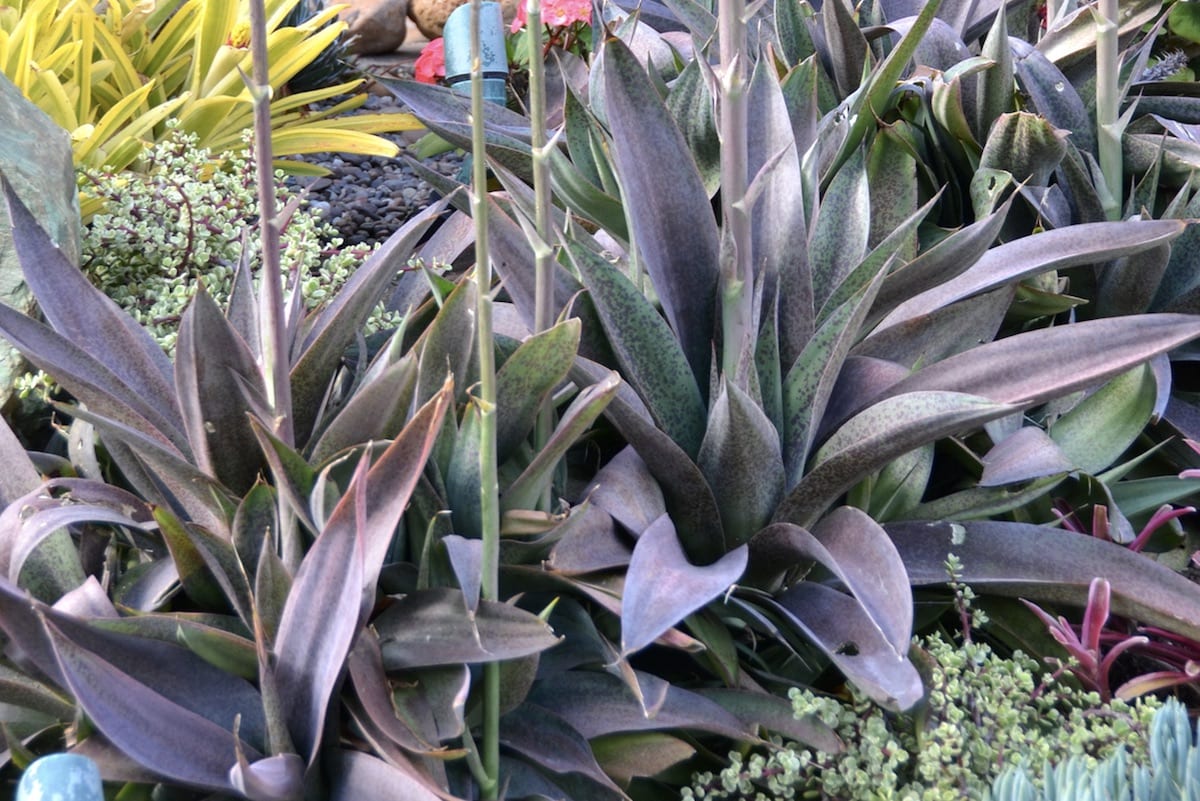
Mangave ‘Macho Mocha’From Designing with Succulents by Debra Lee Baldwin.
The first mangave arrived on the gardening scene 15 years ago: the cultivar ‘Macho Mocha’. According to San Marcos Growers: “…reported to be hardy to 9° F by Tony Avent in North Carolina. This 2004 Yucca Do Nursery introduction…was from seed collected by Carl Schoenfeld while on a plant exploration trip into Mexico.” It attains 2 to 3 feet in height by 4 to 6 feet in diameter.

The best guess is that Agave macroacantha x Manfreda maculata = Mangave ‘Bloodspot’

Mangave 'Blood Spot'
Next came Mangave ‘Bloodspot’ (2008; 1 foot high by 1 to 2 feet wide. Hardy to 20-25 degrees.) The origin is unclear; San Marcos Growers suspects Japan.
In my book, Designing with Succulents (2nd ed, 2015, pp. 224-225), I show both ‘Bloodspot’ and “Macho Mocha’ and say, “If plants can be fashionable, the latest stars are mangaves.” I still feel that way. Mangaves are new, beautiful, interesting, as easy to grow as any succulent—and as for hybridization, the sky’s the limit.
When the mangaves arrived, it was Christmas in January
I don’t grow many exotic succulents. I’m into creating a beautiful garden with those easy to come by. (If common succulents don’t thrive, there’s no great loss.) My few rarities are in pots where I can keep an eye on them. So when the box of mangaves arrived, into pots they went…for the most part. In hindsight, that probably protected a few of them but kept others from attaining their full potential. Regardless, two years later, I’m pleased to report all are alive and well.
I’ll never forget opening that shipment back in 2017. The plants had been greenhouse-grown, and boxing and shipping had caused broken leaves. That made me groan, but I quickly became caught up in identifying their agave parentage. I said aloud to a plant with wavy leaves that looked trimmed with pinking shears, “I’ll bet you’re from Agave gypsophila.” To the spitting image of a very common green agave that was a surprising lavender, I murmured, “Surely you’re not related to Agave attenuata?” All in all, those mangaves were the best gifts I’d ever received from someone I hadn’t met.
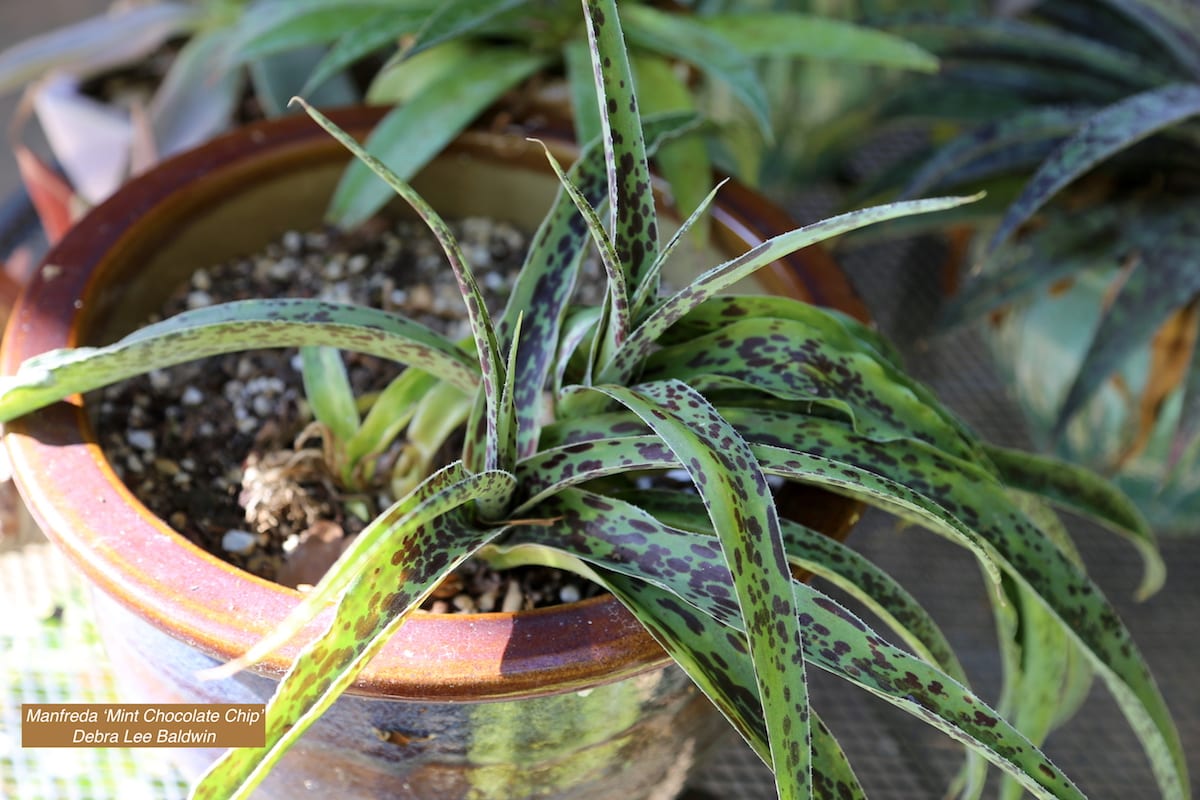
Manfreda ‘Mint Chocolate Chip’
I knew nothing about manfredas, the lily side of mangaves, so I was pleased that Hans had included two.
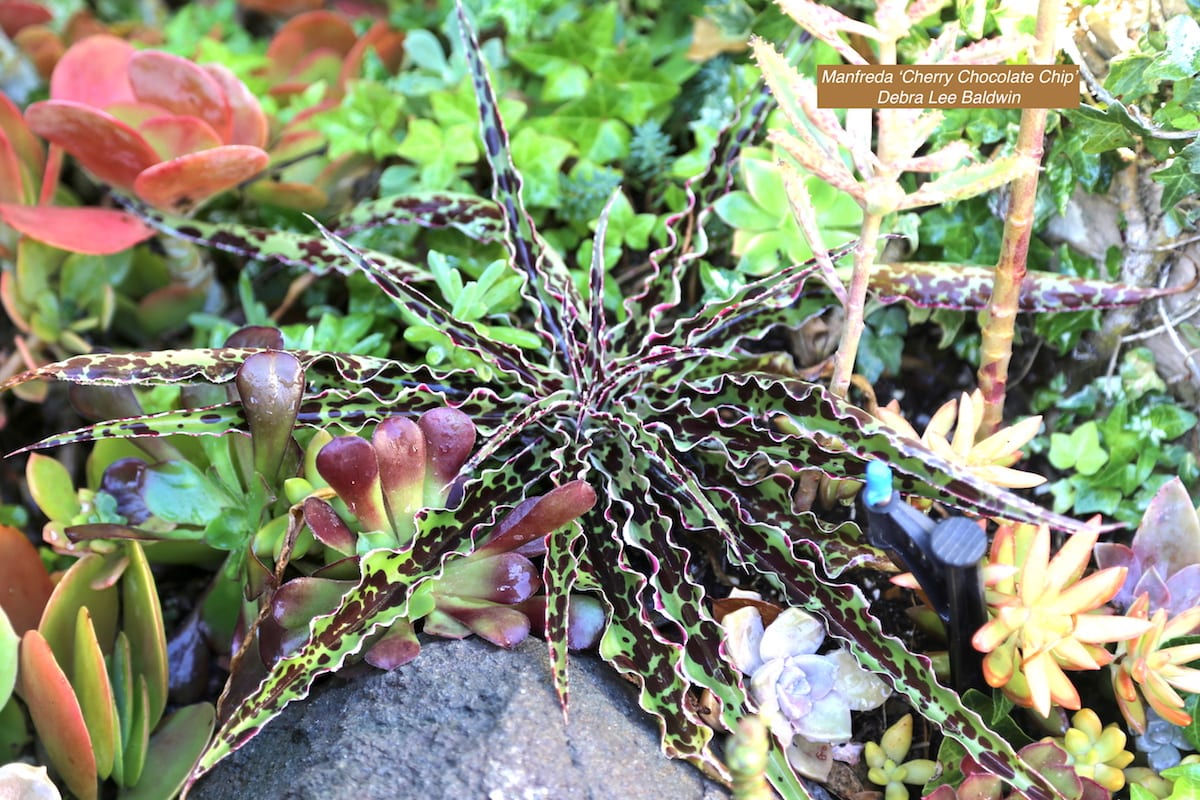
Manfreda ‘Cherry Chocolate Chip’ is a variegated sport of Manfreda undulata ‘Chocolate Chip’.
One manfreda went into a pot, the other, into the ground. The latter started out glorious and stayed that way. In fact, Manfreda ‘Cherry Chocolate Chip’ is now among my favorite plants.
I sheltered all 14 as best as I could from extremes of sun, heat and cold. As it turns out, that may not have been necessary.
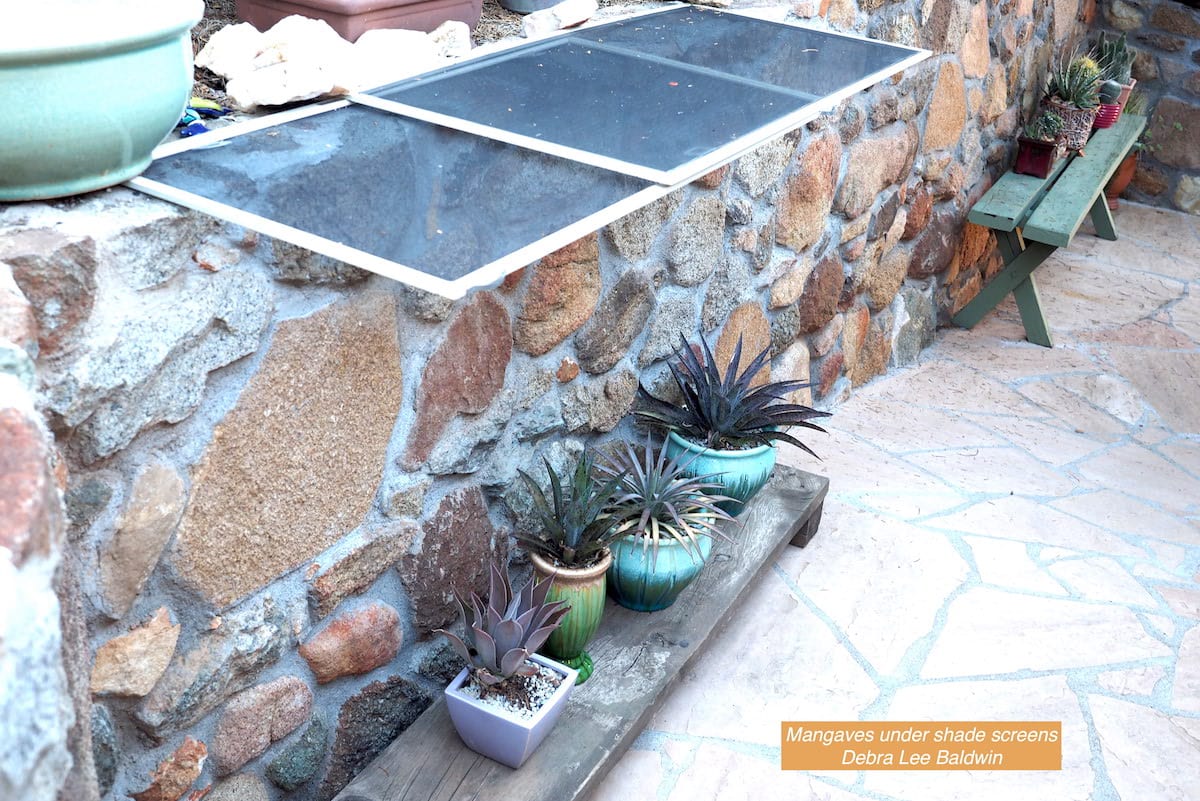
Not taking any chances, I potted and shaded my new mangaves.
That first assortment from Walters Gardens included two manfredas and 12 mangaves.
The list below describes plants from the first shipment and coincides with my January, 2019 video: “Mangaves in My Garden.” Some need repotting or a better location, which I’ve done since or soon will do.
Manfreda ‘Mint Chocolate Chip’ (introduced 2017, see above), has floppy, wavy, narrow leaves. It was beautiful in a pot for months, then seemed to suffer in the summer heat. A section (perhaps a separate plant) bloomed and died back. Tony Avent of Plant Delights Nursery says the rest may have simply gone dormant after blooming and will come back. [See my mangave interview with Tony.] It also may have needed more water than I was giving it, or it wanted to be in the ground. In summer, leaves lost their sheen, and tips dried and shriveled. In fall, ants colonized the container. Above is how it looks now, revived by winter rains.
Manfreda ‘Cherry Chocolate Chip’ (see above) looks delicate but isn’t. (Twelve inches tall by 4 feet wide at maturity. Zones 7b to 9b?) It has done well in a sheltered bed alongside a wall that bounces sunlight onto it, doubtless helping its color. Spider-shaped with tapering, rippled, ribbonlike leaves, it’s fascinating, as are its red blotches and creamy white margins. I’m thinking of removing any blooms to keep the plant strong.
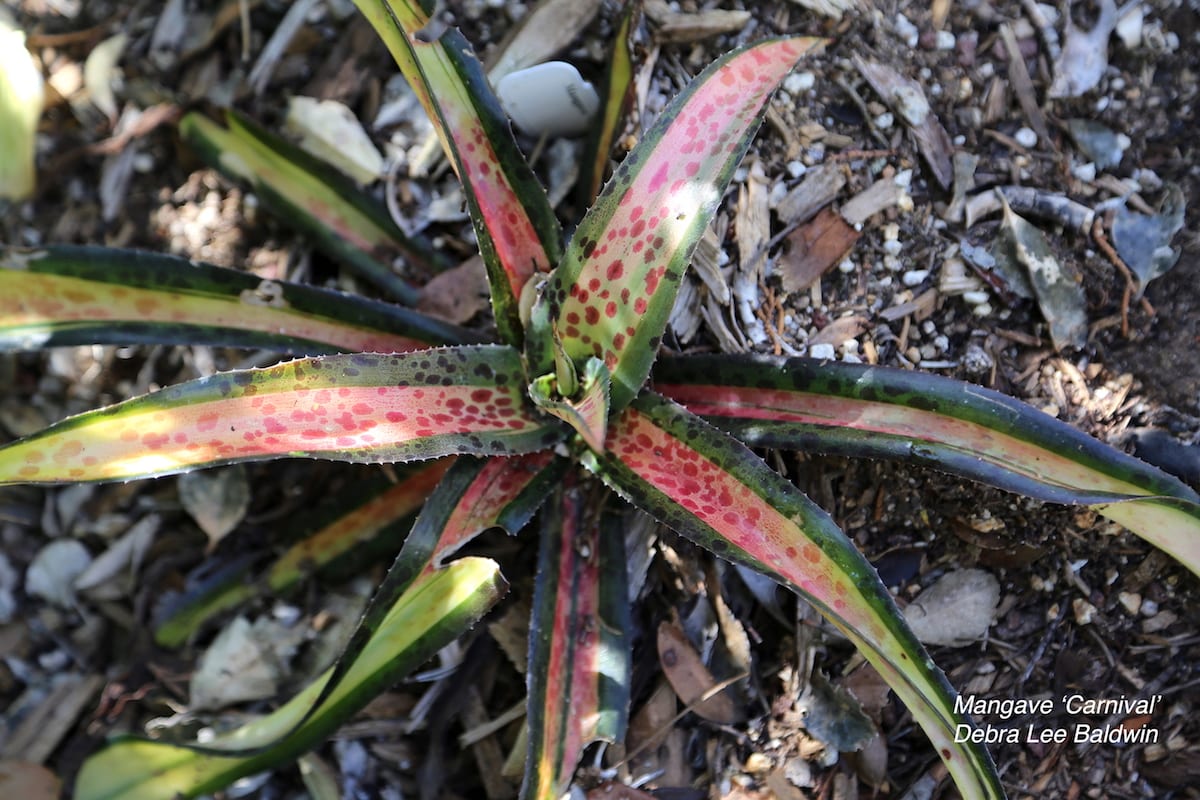
Mangave ‘Carnival’ is a Mangave ‘Jaguar’ cross. Its variegation is the reverse of Mangave ‘Kaleidoscope’.
Mangave ‘Carnival’ exhibits the best and worst characteristics of the new genus: Wonderful rosy-red dots blend with pink, green and cream (the best) and leaves that are too fragile for the plant to exist unscathed in the open garden. It also doesn’t like the summer heat of inland southern CA.
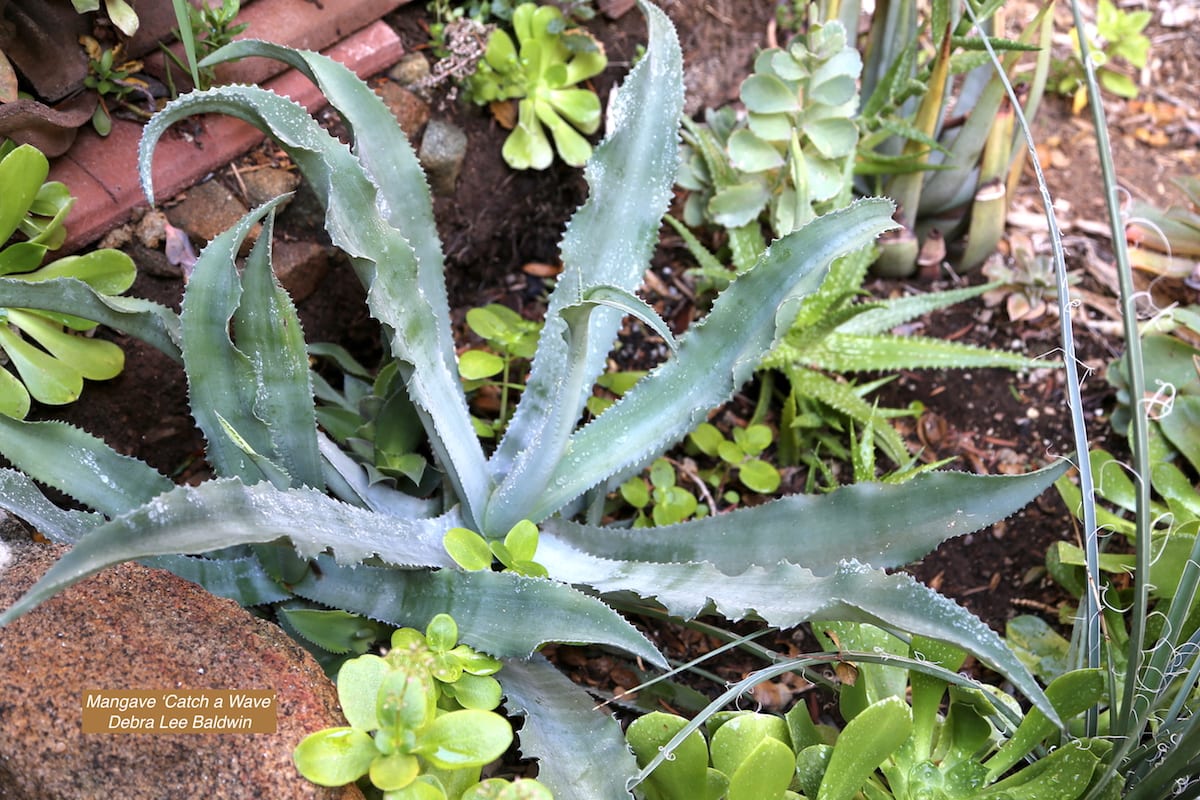
Mangave ‘Catch a Wave’ in my garden (top) and as shown on the Walters Gardens website. (Manfreda maculosa x Agave gypsophila) x Agave colorata
Mangave ‘Catch a Wave’ (2017) has languished in a too-shady spot in my garden, growing and even offsetting, but producing no color other than silvery-blue. Its leaves have elongated, and their pie-crust edges hearken to its A. gypsophila parentage. I may have to move it into greater light to get it to look more like the photo on the Walters site.
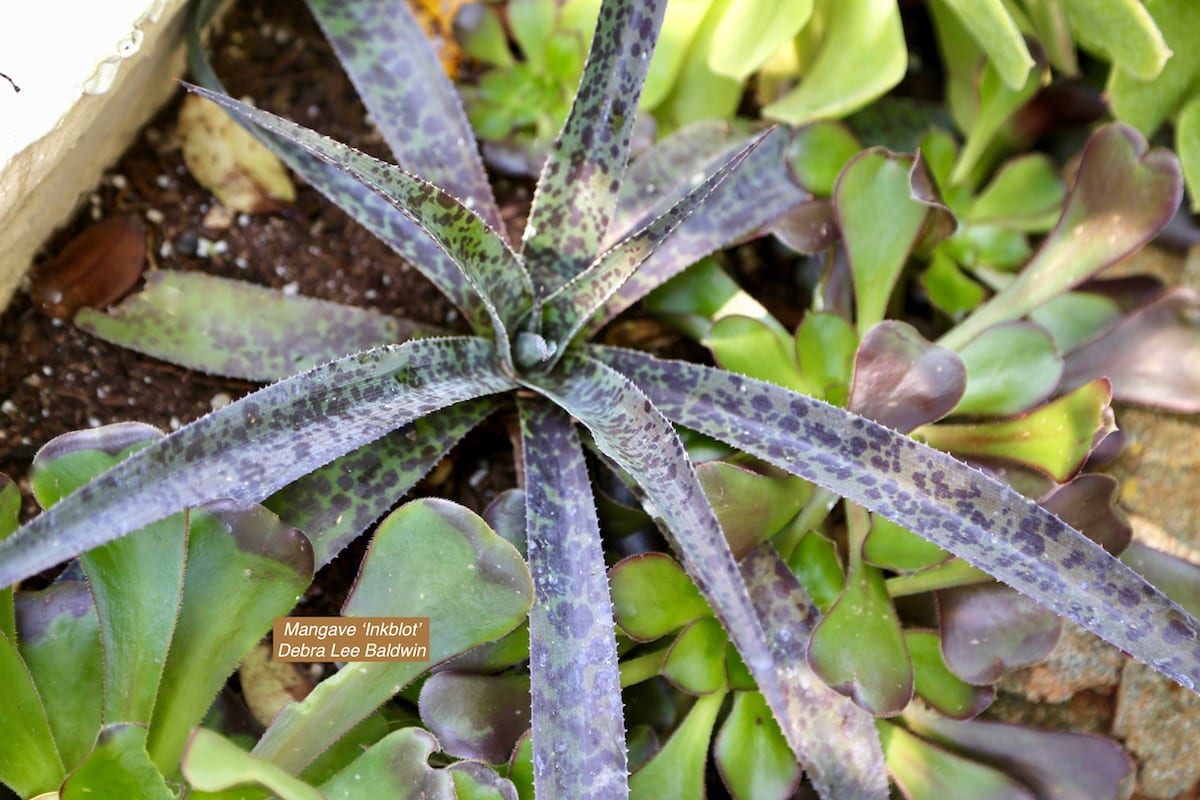
Mangave ‘Inkblot’ (Mangave ‘Bloodspot’ x Manfreda ‘Chocolate Chip’)
Mangave ‘Inkblot’ has long, narrow, flexible, dark green leaves thickly dotted with inky blotches that give it a reptilian look. It’s not a thing of beauty, but it’s interesting.
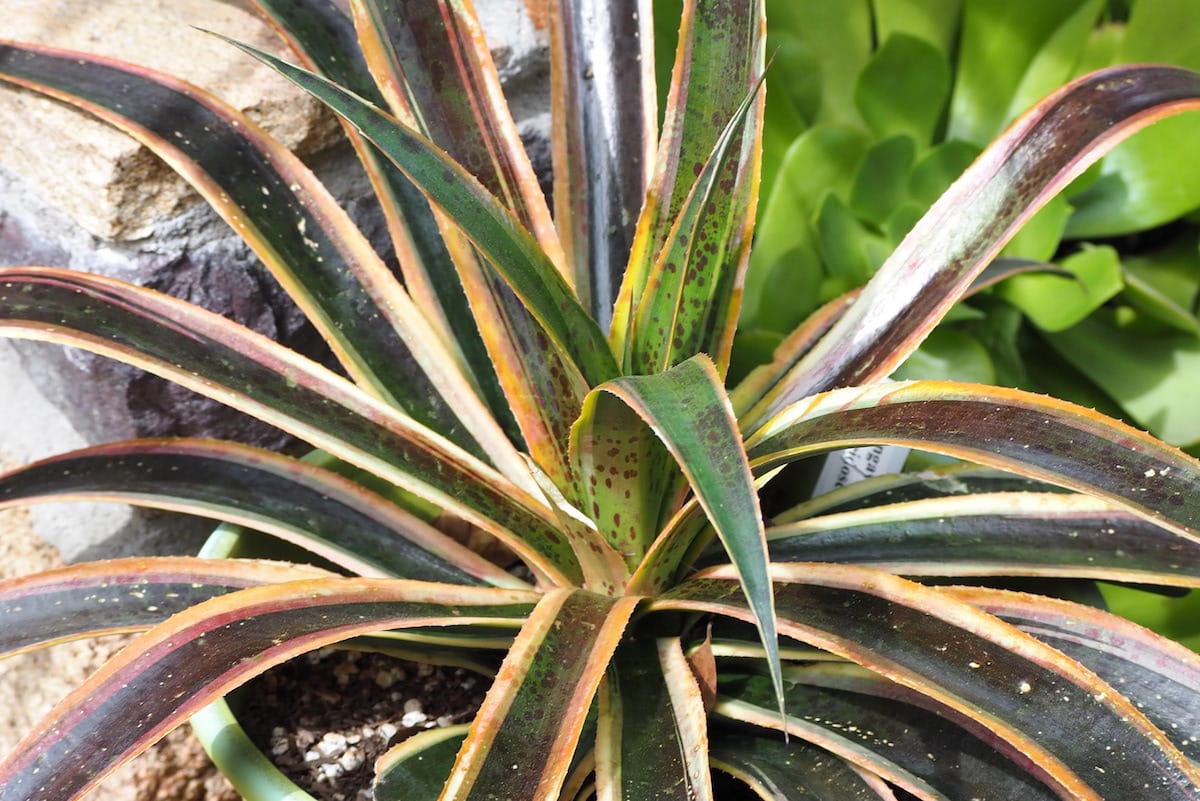
Above: Mangave ‘Kaleidoscope’ given the right amount of sun.
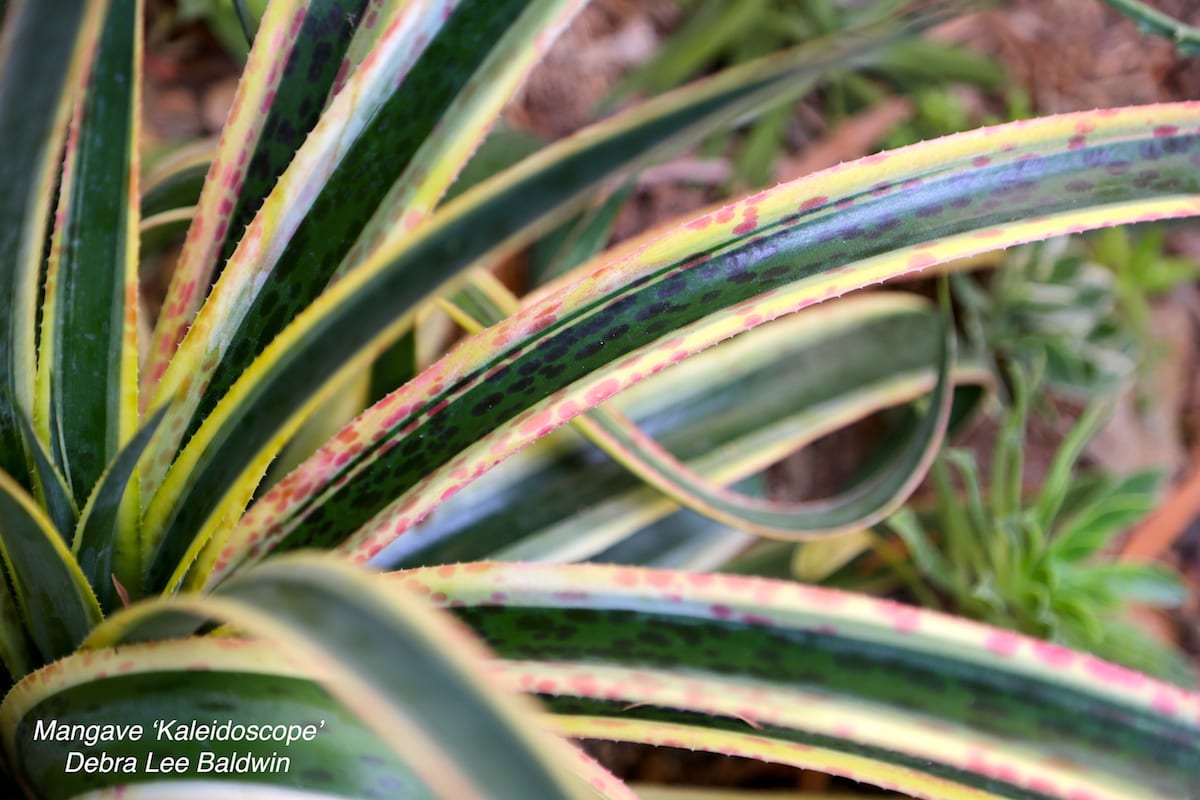
The same plant, after being transplanted into an garden bed that gets too little light.
Mangave ‘Kaleidoscope’ (2016; variegated sport of Mangave ‘Jaguar’. Sun to part shade, 18 inches tall by 2 feet wide at maturity.) ‘Kaleidoscope’ is a fast-growing, stunningly striped and mottled, large multicolored succulent that glows beautifully when backlit. I first planted it in a pot which it quickly outgrew, then transplanted it into the ground where it probably needs more sun. Rather than replanting it a third time, I’ll just trim the tree that’s shading it.
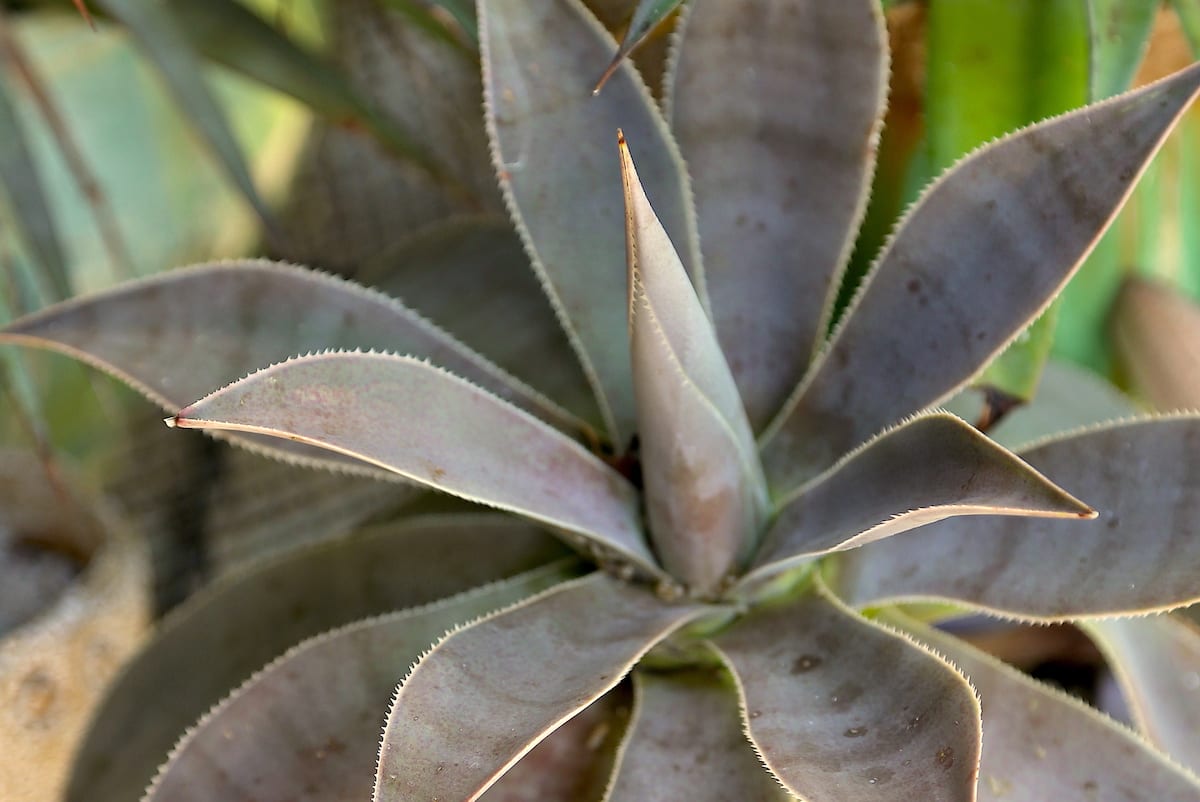
Agave attenuata x Mangave ‘Bloodspot’ = Mangave ‘Lavender Lady’
Mangave ‘Lavender Lady’ (2017. Sun to part shade. 12 inches tall by 20 inches wide at maturity. Frost tender.) Having grown both parents, I was delighted to meet their lavender-gray offspring. I’ve had it in a pink pot for two years, possibly stunting it. I’ll soon find it a place in the garden—one that’s frost-free, because this lovely cultivar lacks hardiness.

Agave stricta x Mangave ‘Bloodspot’ = Mangave ‘Man of Steel’
Mangave ‘Man of Steel’. I’m familiar with both parents, so unpacking this beauty was like a family reunion. Both ‘Bloodspot’ and A. stricta are stiff-leaved, so not surprisingly their offspring is, too. On the plus side, ‘Man of Steel’ is not as delicate as other mangaves. Its thin, silvery, downward-curving leaves offer an elegant and symmetrical—if pointy—silhouette.
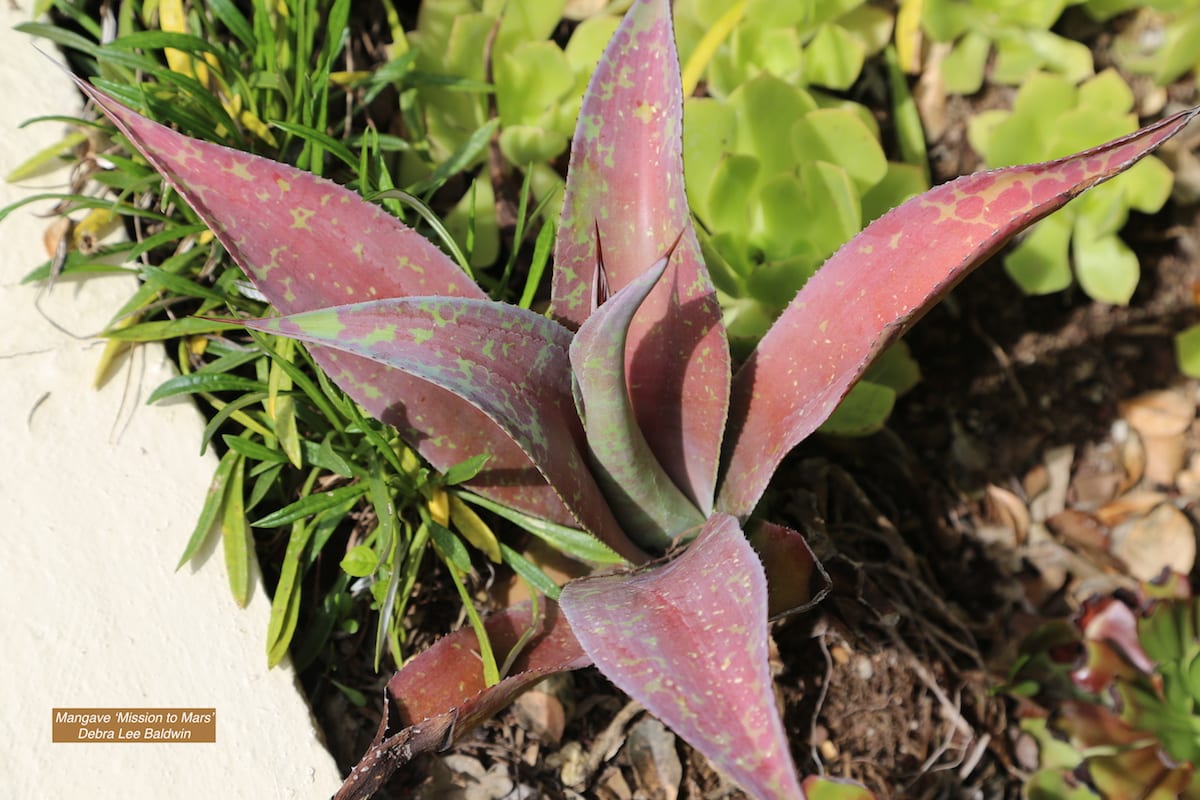
Mangave ‘Mission to Mars’ (Manfreda jaliscana x Agave lophantha) x Agave shawii.
Mangave ‘Mission to Mars’ (2017. Anticipated to be 2 feet tall and 4 feet wide at maturity, Zones 9a to 11?). I’m unfamiliar with its manfreda parent but it must be red and soft, because its agave parents are green, gray and stiff-leaved. The hybrid’s many red blotches nearly cover any green, but in my garden some leaf tips have shriveled. What it lacks in symmetry and form it makes up for in color…pretty much. I might dig it up and see if it does better in a pot.

Mangave ‘Moonglow’ (Mangave ‘Bloodspot’ x Manfreda ‘Chocolate Chip’)
Mangave ‘Moonglow’. Showing the best of both parents with soft, wavy-edged and curling slender leaves, this suggests ‘Inkblot’ with more of a bluish cast. Dots are thick and maroon. I have it in a blue pot that suits it.
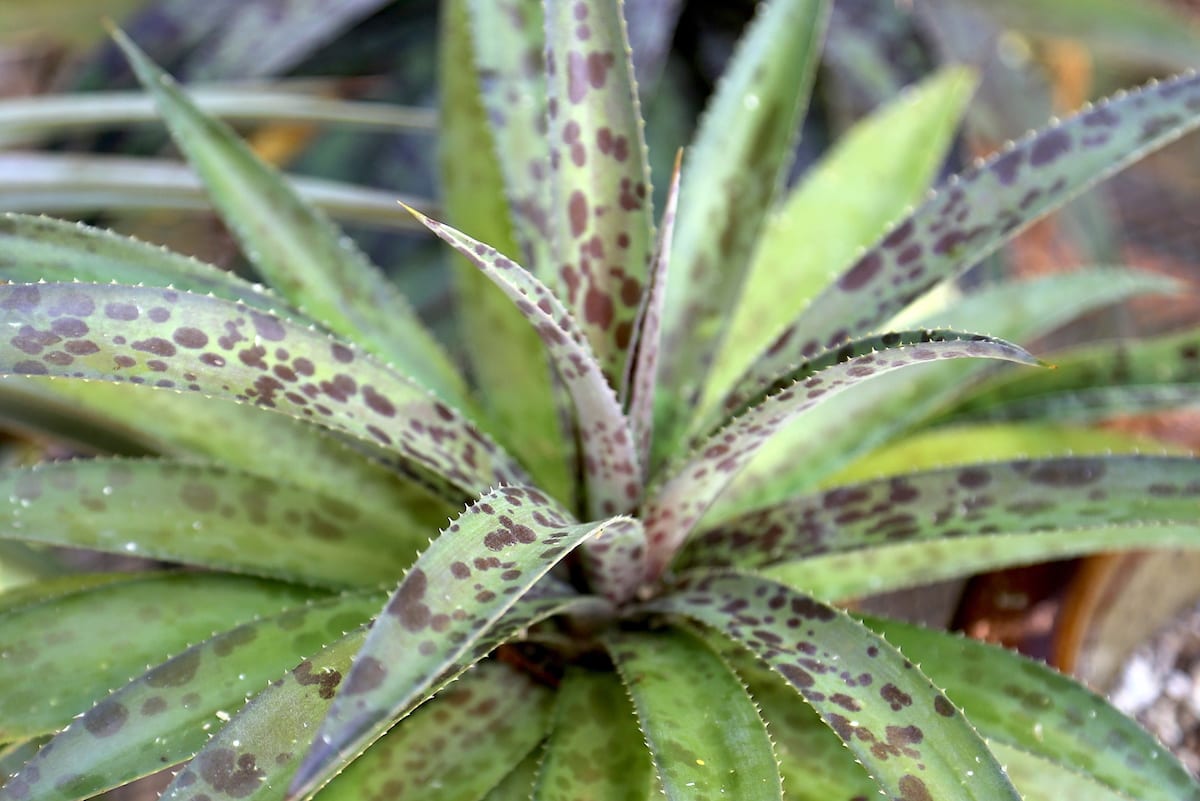
Mangave ‘Pineapple Express'
Mangave ‘Pineapple Express’ on the Walters Gardens website looks like the foliage atop a pineapple, only speckled. The one I planted in a pedestal pot doesn’t have a pronounced, stacked-leaf growth habit. It has stayed fountainlike and nicely dotted, but yellow-green. I’ve since removed it from the pot and expect good things from it in the ground.
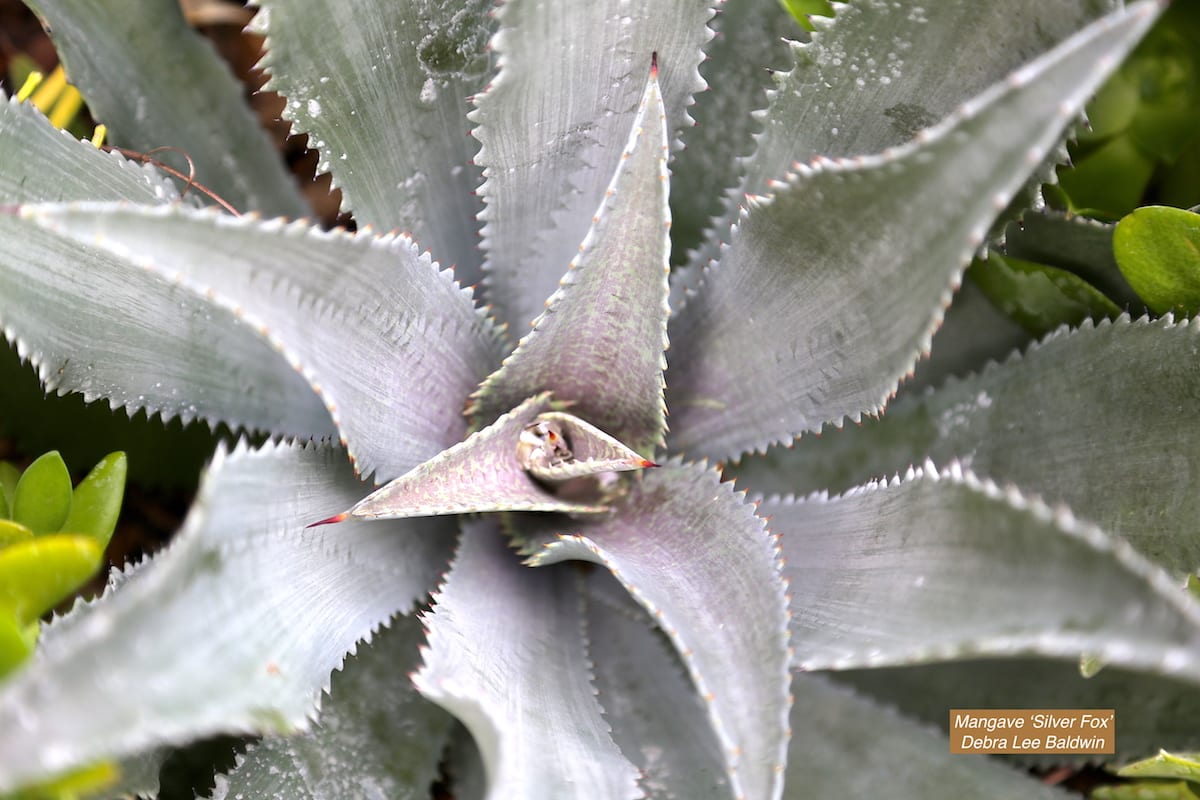
Agave gypsophila x Mangave ‘Bloodspot’ = Mangave ‘Silver Fox’.
Mangave ‘Silver Fox’ (2017. Sun to part shade. Zones 9a to 11? Eleven inches tall by 22 inches wide at maturity.) Nursery photos show a compact, wavy rosette that’s distinctly silvery-purple and rosy-dotted. Mine looks more like a short-leaved gypsophila, minimally freckled. It’s happy but possibly needs more light.
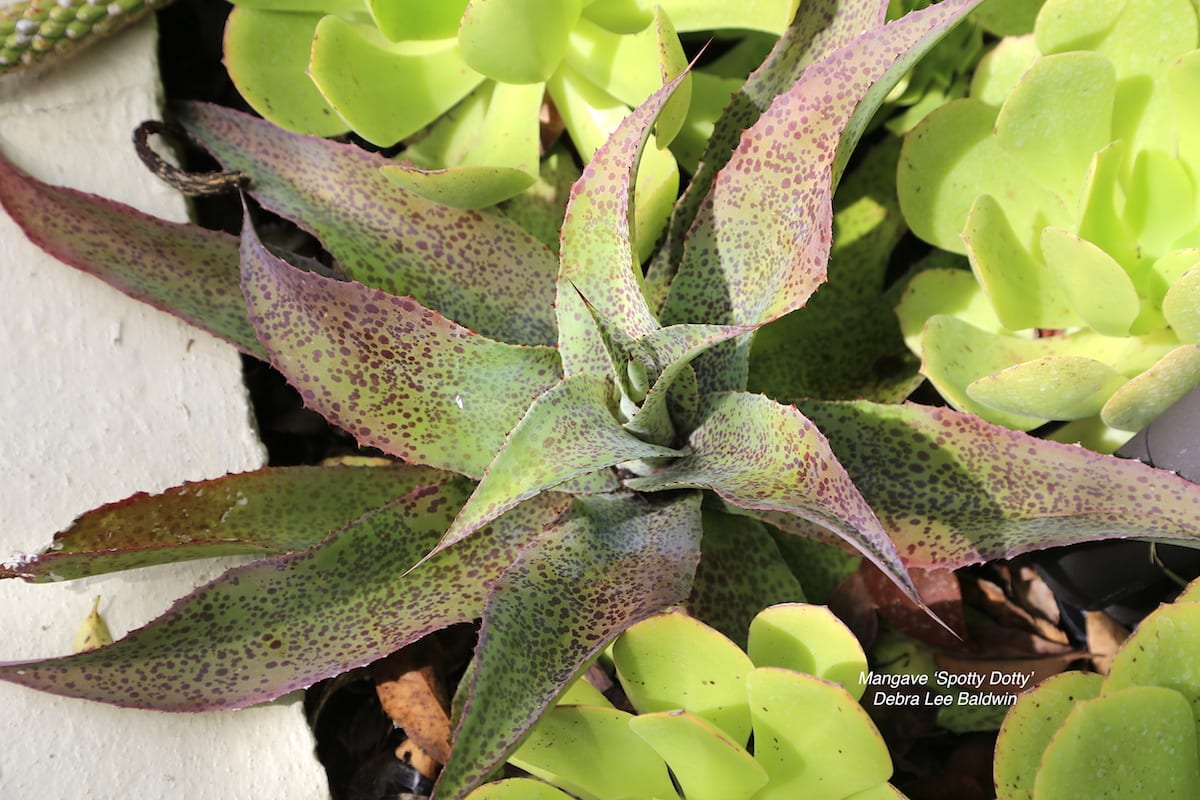
Mangave ‘Spotty Dotty’ (Manfreda maculosa x Agave gypsophila) x Agave bovicornuta.
Mangave ‘Spotty Dotty’. This has performed well in my garden and colored up nicely. Its gently twisting, soft, greenish-yellow leaves are well freckled with red. A favorite.

Mangave ‘Whale Tale’ (Manfreda maculosa x Agave gypsophila) x Agave ovatifolia.
Mangave ‘Whale Tale’ (2018. Sun to part shade. Zones 7b to 11? Twelve inches tall by 4 feet wide at maturity.) Mine has no speckles and simply looks like a nice silver agave with darker areas that lack pulverulence. It’s a lovely plant but again, it probably needs more sun to enhance its color. In my garden, that’s invariably a trade-off: More sun equals greater danger of beige sunburned patches and brown, dry leaf tips.
What is a manfreda?
If you’re into succulents, you’re well aware of agaves. But chances are you’ve never heard of the genus Manfreda. After all, it’s not in the Sunset Western Garden Book. There exist 35 species of these lilylike succulents. Like Agave, Manfreda hails from Mexico, but also ranges much farther north and east. The genus is closely enough related to Agave that the plants can cross, although this rarely happens in nature. Manfreda is also related to Polianthes. Plants in both genera are commonly referred to as tuberoses.
Tuberose leaves form rosettes from a short stem and send up fragrant flowers along slender stalks. Flowers are tubular and whitish, yellow, green, or brownish, with long stamens. Some are wonderfully fragrant. Manfredas, unlike agaves, don’t die after flowering—a nice characteristic they pass on to their intergeneric crosses, the mangaves. Leaf margins of manfredas are smooth or slightly serrated and lack spiny tips.

Manfreda maculosa is the progenitor of numerous crosses
Spotted manfreda, (Manfreda maculosa, commonly called Texas tuberose) has silvery-green leaves covered with purple spots. It’s the one most often seen in cultivation.
According to Plant Delights Nursery: “Like its Agave daddy, x Mangave are evergreen (above freezing) and like its Manfreda momma, it is polycarpic (doesn’t die after flowering) and attracts hummingbirds. The agave parent contributes the evergreen nature and the form, while the manfreda parent contributes the purple spotted pigment. Both parents contribute drought-tolerance and an aversion to winter moisture.”
[See my mangave interview with Tony Avent of Plant Delights.]
Mangaves in My Garden
Back in 2017, before my first shipment arrived, mangaves were not entirely unknown to me. I’d seen two cultivars in high-end gardens by San Diego designer Michael Buckner. I considered the plants expensive rarities and suspected they probably wouldn’t thrive in the comparatively rigorous conditions of my own garden. Located in the foothills of inland San Diego County on a steep, terraced, east-facing slope, it gets frost every winter (down to the high 20s F) and near-desert heat in late summer (into the 90s for weeks). Although I’ve been amending the soil for decades, the substrate is decomposed granite (not a bad thing, it’s well draining) and clay (never a good thing.) Fortunately there’s not a lot of clay—about enough to build an adobe dog house.
The succulents that thrive out in the open in my garden are those that aren’t picky. Full-sun, frost-prone areas are OK for agaves and cacti, and those Southwest succulents that store water in their trunks, such as dasylirions, yuccas and beaucarneas. I have every kind of aeonium in the dappled shade of native oaks and beneath lacy trees, and quite a few aloes, although it’s a balancing act to give the latter adequate protection from weather extremes yet enough sun to bloom.
Tender succulents such as jades, kalanchoes and euphorbias grow in frost-free microclimates beneath eaves, where they bask in half a day’s sun. Apart from shade succulents like sansevierias and toughies like graptoverias and Mexican sedums, others (like echeverias, haworthias and stapeliads) are in pots that I move or shelter as seasons change.
So what about your garden?
Manfredas prefer full sun, short of scorching; well-drained soil that’s kept on the dry side; and room for their root systems to expand. Containers should be at least 12 inches deep. I’ve noticed that mangaves with established rootballs can be difficult to remove from pots. Some sources say that Mangave is a slow grower; others, that it’s much faster than Agave. So far, with the exception of ‘Kaleidoscope’—a mangave on steroids—they seem about the same.
Late spring and summer is the growth season. Like most succulents, mangaves appreciate a dose of diluted fertilizer when emerging from dormancy. They’re fine outdoors in mild climates with minimal rainfall, typical of Southern CA. Elsewhere, overwinter them indoors. Keep them cool and the soil barely moist. In spring, return them to the garden and reintroduce to full sun gradually. They’re not great indoor plants because they need ultraviolet light to color-up.
As for garden design, the aesthetic uses of mangaves are only beginning to be explored. I anticipate that they’ll become commonplace in low-water landscapes throughout the Southwest, likely with a broader range than South African succulents, but not venturing into desert gardens. I could be wrong about that, but mine don’t seem to like late-summer heat. The plants’ soft, arching leaves and interesting spotting and striping will likely make them collectible novelties, beginning in California and spreading worldwide.
By the mid-’20s, mangaves will doubtless be commonplace. The certainty of new cultivars selected for desirable colors, variegation, toughness, growth habit and size means there’s no limit to what’s possible—from upright, spiky, speckled, stiff-leaved, agave-lookalikes to ribbon-foliaged lilies that are languorous, loopy, crenellated, freckled and noodle-soft.
Mangave drawbacks
The main drawback to early Mangave cultivars, especially those bred not to “bite” (i.e. they lack the needlelike tips and barbed teeth of their Agave parents) is soft, flexible, thin and brittle foliage that’s prone to tearing or breaking, and is easily damaged by snails or impact. Place such plants out of harm’s way to avoid compromising their beautiful symmetry. Although they’ll outgrow breakage, mangaves are succulents that shouldn’t be stepped on, even by a chihuahua.
They’re also vulnerable to agave snout weevil infestation.
Find out more about mangaves…
Plant Expert Tony Avent on Mangaves
Tony Avent, Plant Delights Nursery, Raleigh, NC
According to plant expert Tony Avent, owner of Plant Delights Nursery in Raleigh, NC, “the world of mangaves is exploding. The colors and forms continue to break new barriers of previously inconceivable foliage.” Founded in 1988, Avent’s nursery is a premier source of rarities and natives…[Continue reading]
Visit the Mangave page on the Plant Delights Nursery website.
Connect with hybridizer Hans Hansen by following his Facebook “Mad About Mangave” page.
Watch my Mangave videos:
Mangave Unboxing (8:44)
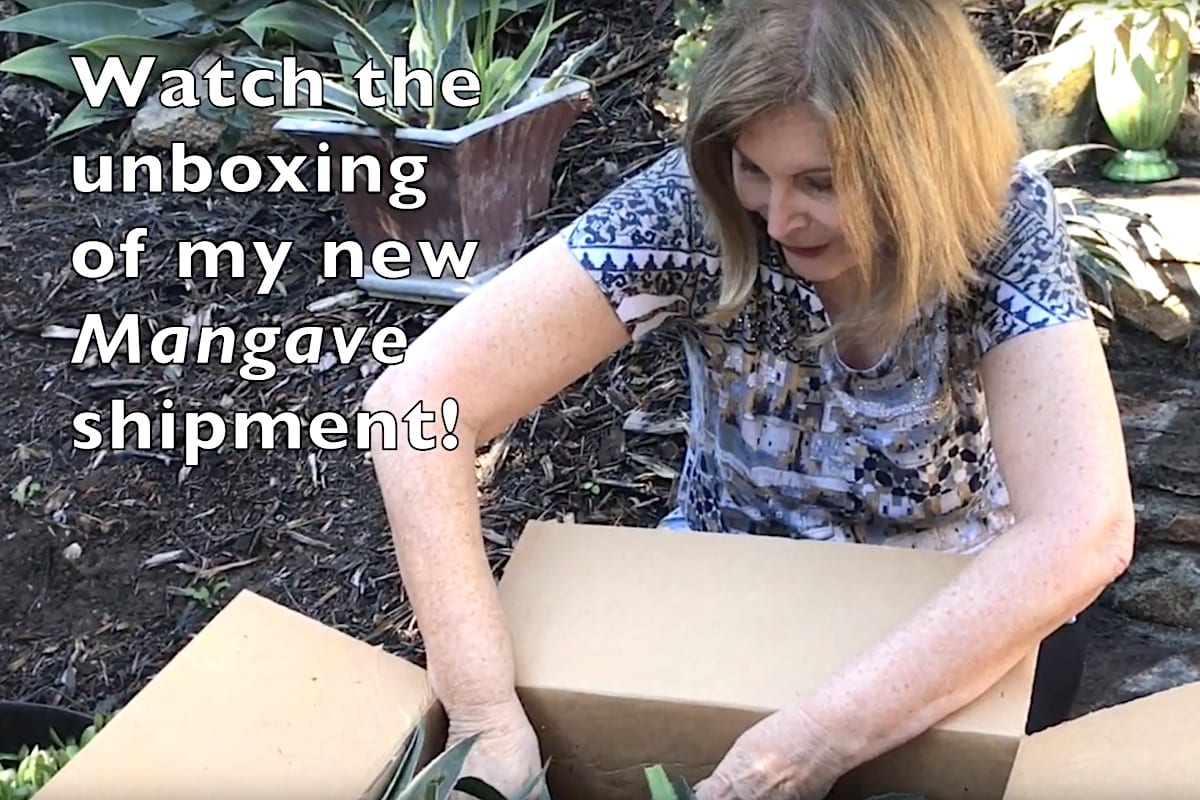
Mangaves are succulents with agaves in their parentage. Many of these 21st-century hybrids are lilylike, with flexible leaves, and do well in gardens that get frost…even snow! Watch me unbox some freckled beauties never been seen before…including a rare Hansera!
My Dozen Mangave Cultivars (5:38)
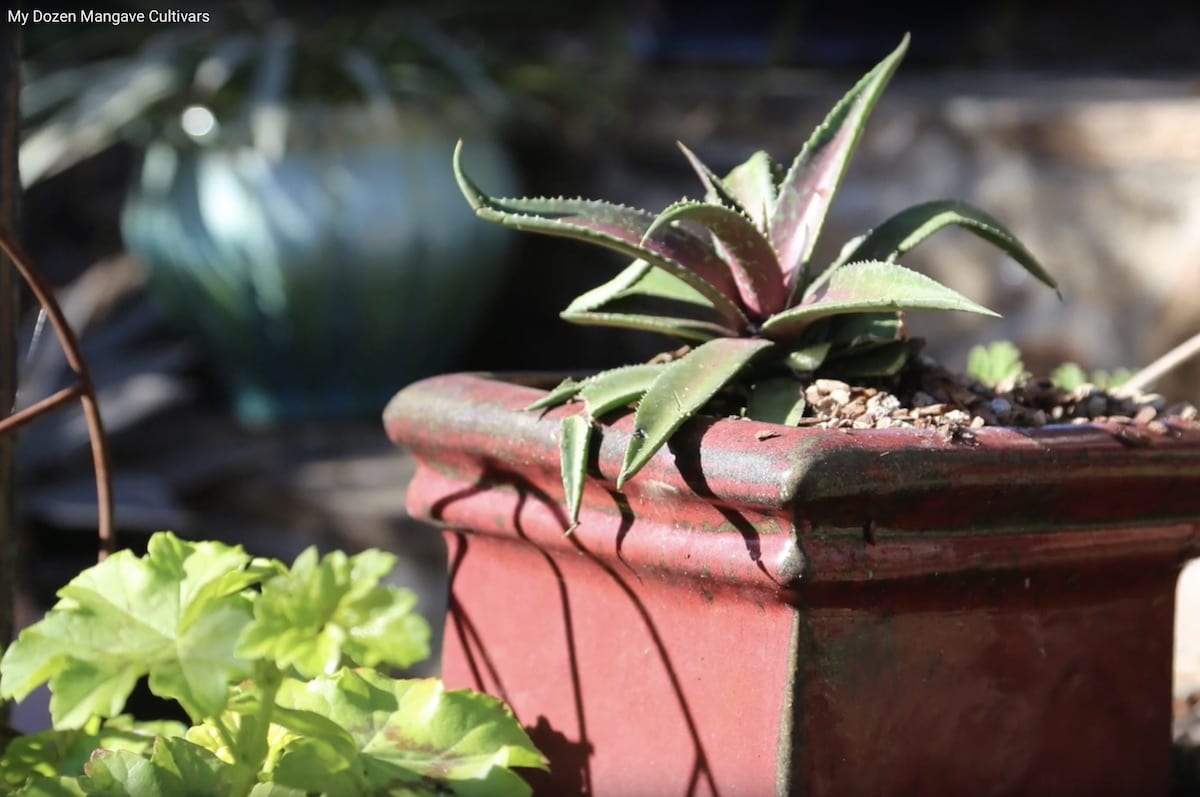
Come on a mangave treasure hunt with me as I track down a dozen cultivars that have been in the ground and in pots for two years. All have done well and some better than others. I evaluate the plants’ progress and how to attain their full beauty and potential.
Planting Mangaves (5:31)

With 18 exciting new Mangave cultivars to find a place for in my garden, I design and plant my new “Mangave Terrace” and perform “C-sections” on potbound cultivars rarin’ to go.
WHERE TO FIND MANGAVES ONLINE:
Plant Delights Nursery
Mountain Crest Gardens

Very informative – thanks! I completely agree that once gardeners catch on to the beauty of these plants they will become more more widespread.
I’m in the same hardiness zone ( tho on SF Peninsula so possibly more maritime influence) and just started growing mangaves and manfreda over the last few yrs myself. I defaulted to full sun for my 4 – 5 varieties and so far so good. The stand out is ‘Mission to Mars’ which has been in the ground for only 6 – 8 months but has more than doubled in size – now roughly 1’h x 2’w. A beautiful plant! I wish I could buy directly from Walters Gardens – or get surprise boxes in the mail like yourself 🙂
good job!
I have a place in northern Starr County in Texas , the weather there is so hot and humid . if you ever want to have someone try plants in that area let me know . average rainfall 12″-25 ” rain a year. The sun itself will burn plant starting in July to September .not for drought resistant plant , they have to be drought tolerant or is there an other word for it?
I have a Mission to Mars mangave I planted in ground, it has done great so far. I am zone 8B in Texas, I put some organic cactus soil to fill the hole around it. I have had it planted almost two months now. I’d upload a pic if I could. Can’t wait to get more mangaves, I will get them from Tony in NC. I have been looking at his inventory. Also Love your blog!
That’s wonderful, Brieanna! Let us know how it handles the winter in your area.
I planted a mangave ‘chocolate chip’ a few years ago in an area with perennials. I regret it!
The mangave became invasive.
I am still digging out mangave shoots years later. I am hesitant to plant my other potted mangaves in the garden grounds for fear of the same thing happening. Has anyone else had this (invasion) occur? The mangave was planted in a “drought tolerant” perennial bed with other plants.
May be it got too much water (more than a desert treatment) and became invasive because of it.
I have not seen mention of this mangave invasive-ness elsewhere.
Hi Dana — This is the first I’ve heard of any mangave being invasive. I’m wondering where you live? One person’s prize specimen is another person’s weed, depending on varying locations and growing conditions. Wait…Isn’t ‘Chocolate Chip’ a manfreda, not a mangave? That might explain it. Manfreda is the genus crossed with Agave to create Mangave. Native to Mexico. Btw, I’m in Southern CA Zone 9B and my ‘Chocolate Chip’ is happy but by no means prolific. I wouldn’t mind if it gave me a few offsets.
About two years ago I planted two Mangave ‘Whale Tale’ in separate raised beds. They both grew beautifully and bigger than I expected to just over 3′ wide.
One of the plant flowered already this summer though. I think it’s dying (no more growth from the middle of the plant), but it is growing offsets in between the existing leaves.
How do I separate the offset from the main plant? They are really tucked in.
Should I just wait until they are bigger? I have pictures of the plants at different stages including flowering, but I don’t know how to share them here.
Thanks!
Hi Chiara — Water the area well and wait a day or so for it to penetrate and soften the soil. About six inches from the offsets you want to harvest, insert a shovel as far as it’ll go. Push down on the handle at an angle to elevate about a third of the root ball. That should be enough to let you wiggle and pull off little plants, roots and all. When you’re done, firm the soil around the mother plant.
Re sending photos, subscribers to my “Celebrating the Joy of Succulents” newsletter can do so by simply hitting “reply.”
Hi Debra, thank you for your detailed instructions. I’ve done that in the past with Agave americana and other succulents but this Mangave is not growing the offsets at the base of the plant, but in between higher leaves.
I am a subscriber of your “Celebrating the Joy of Succulents” newsletter, which I love BTW!
I didn’t realized I could ‘reply’.
I’ll do that and send you pictures!
Thanks
I got 2 Mangaves plugs from Mountain Crest Nursery. Rather than growing on, they have been shrinking away, to the point where I almost tossed one, except it had a tiny new spike in the center. I am in Zone 9b, and they may have gotten too cold, although they were in a shed during the coldest parts. I have moved them around trying to find a spot they like, but not successful.
I have also gotten tiny 2” sempervivums from Mountain Crest, and after a year or so, they got mealy bugs and are fading away.
My impression is that these tiny succulent starts just don’t thrive. What is your experience?
Hi Linda — There’s a reason shops that grow and sell plants are “nurseries.” It takes maternal vigilance (those mealy bugs!) and TLC to successfully grow baby plants and seedlings.
Developing roots need to be kept uniformly moist but not soggy, which is why it’s easy to lose them to desiccation or rot. I confess I’m not very successful at it because I forget to check on them.
But when I do have a tender little thing, still in diapers, that I truly care about, I set it where it’ll get dappled shade, is protected from frost, and gets watered regularly by an automatic system…
…Or checked daily by me…which means it goes on the table on my deck, which I often see (and can’t ignore) from my kitchen and dining room windows.